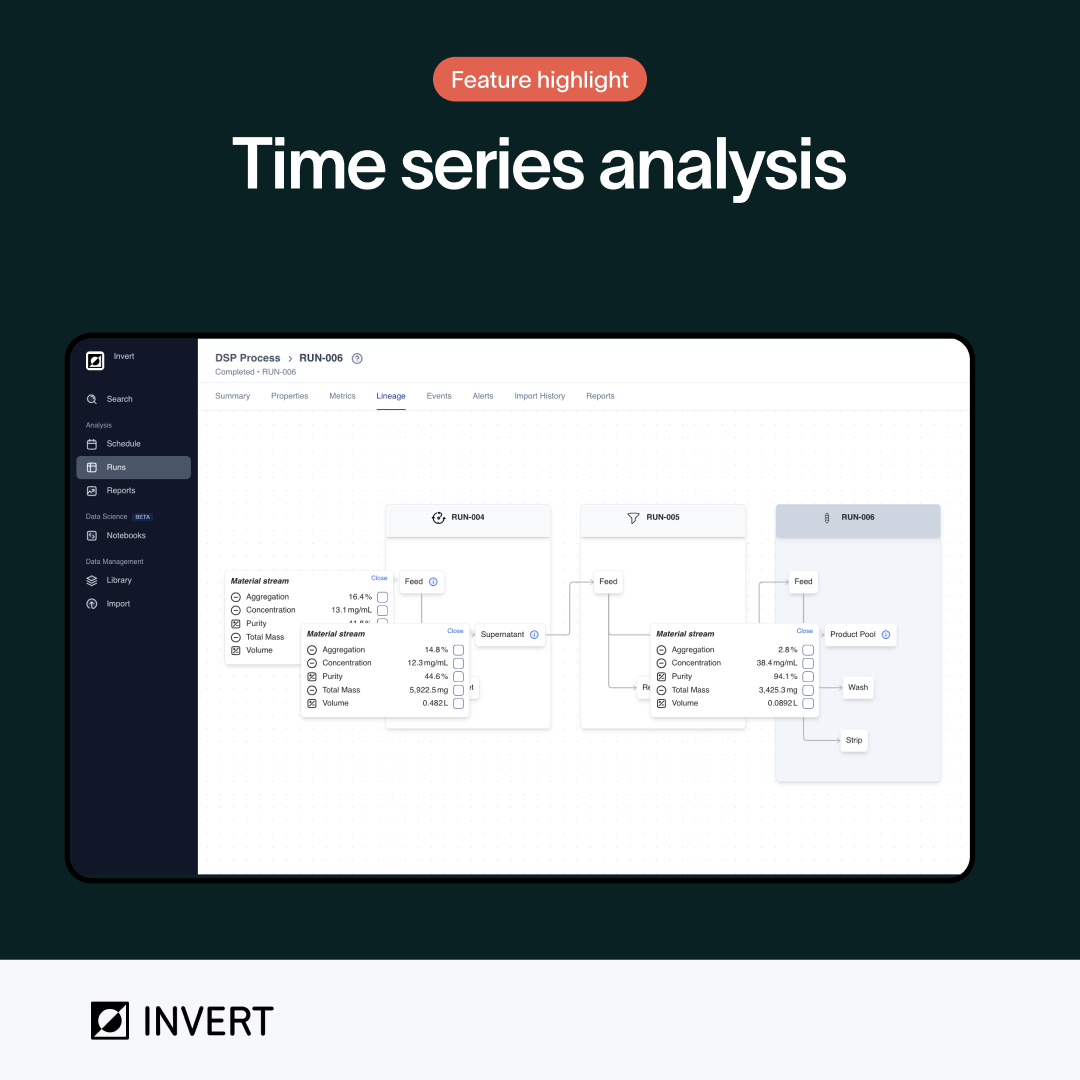Invert Launches Invert Assist

Invert Assist: AI that speaks bioprocess—just like you do
Today, Invert launches Invert Assist, the first AI-powered analysis interface built for bioprocess. Using a simple chat interface, Invert Assist enables users to perform complex analysis that typically takes an expert team hours to code manually. With the freedom and flexibility of natural language, bioprocess scientists can turn days or even weeks of troubleshooting and optimization into a 5-minute conversation with their data.
Why now?
We produce roughly 180 zettabytes of data per year. To put that number in perspective, that exceeds the number of stars in the observable universe.
This massive amount of data means that most of it is under-utilized, and bioprocess data is no exception. The sheer volume of data produced means the vast majority of it is siloed and fragmented across upstream and downstream process, or between scales or sites of production. New modalities in cell and gene therapy and biologic manufacturing also contribute distinct challenges — tracking interdependent CQAs during viral vector production for gene therapies, or managing batch-to-batch variability for autologous cell therapies.
It’s clear that the biggest bottleneck in data isn’t producing it, but in being able to use it to close the gap between analysis and action. As articulated by Amgen CTO David Reese, “…those who figure out how to organize, harness, and analyze that data will separate the winners from the rest.”
Invert’s launching Invert Assist to create those winners.
What can Invert Assist do?
One of the main reasons why enterprise AI initiatives fail (source: MIT) is their inability to integrate deeply with domain-specific workflows. Invert Assist was designed, first and foremost, to fit seamlessly in bioprocess workflows.

Invert Assist is capable of performing both routine and more sophisticated analysis and modeling for bioprocess. It can detect trends and correlations between runs, conduct root cause analysis for deviations, construct predictive models and simulations of processes, and design future experiments based on current data.
If you’re interested in learning more about how Invert Assist could support your processes, request a demo here. Our team would be happy to put together a demo tailored to your specific use cases and needs.
Why Invert Assist?
Invert Assist only sources high quality, fully contextualized data from Invert’s core software. With a foundation of AI-ready data, users can be confident that results are grounded in their own bioprocess data from the bench to the manufacturing floor. We’ve also developed in-house evaluations tailored to bioprocess specifically to assess Invert Assist’s performance, ensuring that its answers are consistently accurate and reliable.

Unlike general-purpose large language models (LLMs) like ChatGPT, Invert Assist was also built to be compliant with biomanufacturing industry regulations and adhere to international best practices for AI use and development. Results from Invert Assist are fully traceable and audit-ready, which means users will not only be able to access the Python code used to execute analysis, they’ll be able to reproduce and verify them as well.
Just like Invert’s core software, Invert Assist is built with enterprise-grade infrastructure and adheres to strict industry standards for data privacy and security. Neither Invert nor our vendors ever train AI models on customer data.
Experience Invert Assist today
Seeing Invert Assist at work with your own process data is quick and easy. We’re introducing Invert Insight Sprint, a new POC offering that lets you get an immediate look into the power of AI-driven insights.
All we need is a few files of your historical data, like historical runs, deviations, or yield summaries. After signing an NDA, we’ll upload that data onto Invert, where it’ll automatically be made AI-ready. Then, you’ll be all set to start talking to your data:
- Ask real questions (“What parameters led to low yield last quarter?”)
- Uncover hidden trends (“Which sites show the most variability?”)
- Quantify what could have been prevented (“If we’d had Invert, we could have saved 10 runs.”
In a few minutes, you’ll find out what you could’ve learned from your data if understanding it was as easy as a casual conversation with a colleague. Find out more about Insight Sprint by reaching out on our website.
.png)
Engineer Blog Series: From Bioprocess to Software with Anthony Quach
Welcome to Invert’s Engineer Blog Series — a behind-the-scenes look at the product and how it’s built.In this post, software engineer Anthony Quach shares how his career in bioprocess development led him into software, and how that experience shapes the engineering decisions behind Invert.
Read More ↗
Connecting Shake Flask to Final Product with Lineage Views in Invert
Invert’s lineage view connects products across every unit operation and material transfer throughout the entire process. It acts as a family tree for your product, tracing its origins back through purification, fermentation, and inoculation. Instead of manually tracking down the source of each data point, lineages automatically show material streams as they pass through each step.
Read More ↗
Engineer Blog Series: Security & Compliance with Tiffany Huang
Welcome to Invert's Engineering Blog Series, a behind-the-scenes look into the product and how it's built. For our third post, senior software engineer Tiffany Huang speaks about how trust and security is a foundational principle at Invert, and how we ensure that data is kept secure, private, and compliant with industry regulations.
Read More ↗